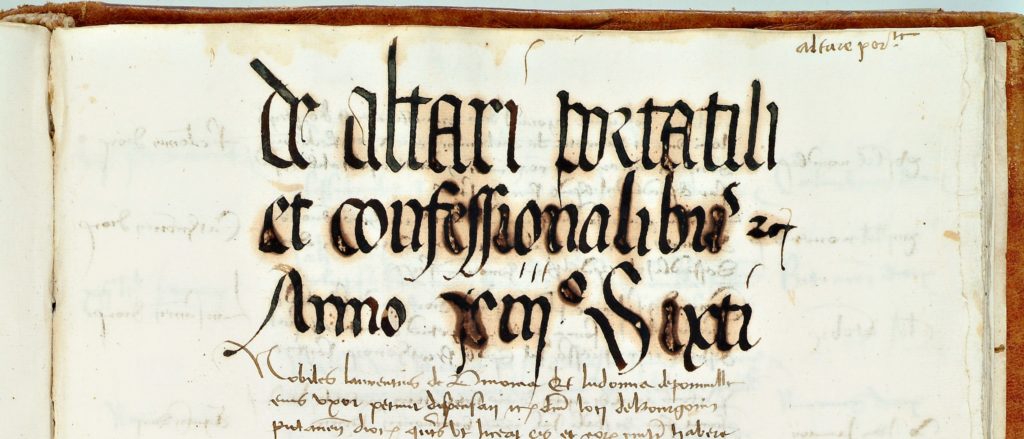The question of the theological efficacy and popularity of late medieval confession is one that has occupied a central role in narratives of the Reformation from its outset in the sixteenth century to present historical scholarship. Early Protestants decried morally corrupt and ignorant priests as a major need for ecclesiastical reform or reinvention. Modern scholars have in many ways contested, refuted, or reshaped historical understanding of the Reformation, but they have not done so regarding late medieval priests, and in particular, priests’ role as confessor.
Historians such as John Bossy and Thomas Tentler responded to the need for a reevaluation of late medieval confession and its massively influential role in late medieval religious life.[1] Both studied fifteenth-century, printed confessional manuals to show the theological robustness of medieval confession, as well as the large number of surviving copies of confessional manuals. Based upon both qualitative evaluations of theological shifts in confessional manuals and quantitative examinations of printed copies of confessional manuals, Bossy and Tentler demonstrated that late medieval confessional manuals were immensely popular and responded to major theological questions and objections of the day. Tentler notes that three confessional manuals, St. Antoninus’s Confessionale, Andreas de Escobar’s Modus Confitendi, and Guido de Monte Rocherii’s Manipulus Curatorum were some of the first international bestsellers of any printed works.[2] These best sellers survive in the dozens or, in rare cases, the hundreds. These manuals had multiple printings across the fifteenth and into the sixteenth centuries, itself an indicator of widespread popularity and steady demand for this type of theological work.
If confession itself was not to blame for the late medieval criticism surrounding the sacrament of penance, who then was the culprit? An understated, but explicit conclusion of Tentler and Bossy is that it was the role of the late medieval confessor who bore the blame for any dissatisfaction for the sacrament of penance. Both scholars suggest that enthusiasm for confessors’ authority and their dominion over personal life perhaps led to resentment or anger.
Here, I would like to offer an alternative to Tentler’s and Bossy’s estimation of the late medieval confessor, using a different set of quantitative sources, these drawn from the registers of the papal office known as the Apostolic Penitentiary. The Apostolic Penitentiary was a papal invention of the thirteenth century to oversee local religious life, specifically to arrogate the authority to forgive specific serious sins to the pope. By the fifteenth century, the office had grown to encompass the handling of requests for a new confessor. Parishioners could appeal to the papal office for their own personal confessor and altar, thereby approximating a personal parish within a late medieval household. The appointed confessor could travel with the household across diocesan lines, and such a religious right was popular with late medieval merchants and lesser nobles.
Records of these supplications survive for much of the fifteenth century, listed under the title of De Confessionalibus within the registers of the Apostolic Penitentiary. Two scholars, Kirsi Salonen and Ludwig Schmugge, have counted the entirety of these supplications for the fifteenth century across Western Europe[3]:
| De Confessionalibus | Amount | Percent |
| British Isles | 665 | 5 |
| France | 7,137 | 52 |
| Germany | 2,866 | 21 |
| Spain and Portugal | 841 | 6 |
| Italy | 1,257 | 9 |
| Northern Europe | 111 | 1 |
| Unknown, Unlabeled | 107 | 1 |
| Total | 13,662 | 100 |
Salonen and Schmugge’s count of supplications provides a startling new look into the enthusiasm behind late medieval parishioners’ desire for a personal confessor. A total of 13,662 supplications for a personal confessor exist for the fifteenth century, but that does not reflect the actual amount of people affected by these requests. In most supplications under De Confessionalibus, a husband and wife would both be included in the request, along with the assumption that any children they may have had were also under the jurisdiction of their newly appointed confessor. Based on this information, we could double or even triple the number of surviving requests to more accurately reflect the number of people involved in these supplications.
Arguing based on sheer amounts of surviving material is a tricky subject for any medievalist, we are all aware of the vicissitudes of medieval source material surviving into the modern era. Using the quantitative material of Tentler and Bossy leads us to one way of viewing late medieval confession and the confessor, Salonen and Schmugge’s data of the Apostolic Penitentiary draws us to a different conclusion of the confessor. Regardless of quantitative choice, it is clear that confession and confessors played a central and high demand role in the religious life of the Late Middle Ages.
Sean Sapp, PhD Candidate
University of Notre Dame
[1] John Bossy, Christianity in the West 1400-1700 (Oxford: Oxford University Press, 1985); Thomas Tentler, Sin and Confession on the Eve of the Reformation (Princeton: Princeton University Press, 1977).
[2] Tentler, 49.
[3] Kirsi Salonen and Ludwig Schmugge, A Sip from the “Well of Grace”: medieval texts from the Apostolic Penitentiary, (Washington D.C.: Catholic University Press, 2009).



